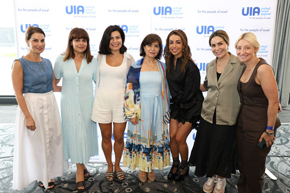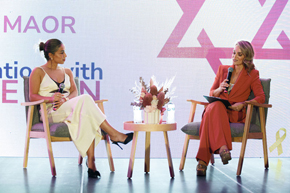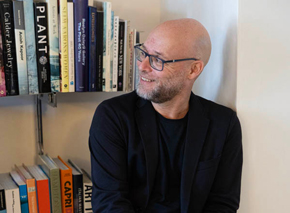From Australia’s Jewish Past
Dr Ernst Leslie Fuchs – a key advocate of the International Modern Movement in Australian architecture

Ernes Fooks
Ernst was born on 6 October 1906 in Bratislava, Czechoslovakia, which, at that time, was part of Austria-Hungary. His family moved to Vienna in 1908 where he studied architecture at the Vienna Technical University, which he completed in 1929 and then went on to complete a doctorate in Technical Science with a major in Town Planning. Before completing his doctorate in 1932, he had a two-year interlude when he studied psychology. His thesis titled Stadt in Streifen (‘Linear City’) was completed under the supervision of prominent Viennese architect Siegried Theiss.
He went into private practice in 1932, entered competitions, published articles, and exhibited his paintings. He practised until 1938 when he was forced to flee as the Nazi government made it increasingly difficult for Jews to remain in the country and with his Latvian-born wife Noemi, he migrated to Melbourne via Canada in May 1939. He was employed as a town planner with the Victorian Housing Commission. In 1944 he was appointed the first lecturer in town planning at the Melbourne Technical College (now the Royal Melbourne Institute of Technology). In 1945 he became an Australian citizen and anglicised his name to Earnest Fooks. Three years later he resigned from the Victorian Housing Commission and opened his own practice. In August 1948 he was elected Associate of the Royal Institute of British Architects and was later elected President of the Jewish Society of Arts.
Ernest and his colleagues Robin Boyd and Harry Seidler became key advocates of the International Modern Movement in Australian architecture. Their style became characterised by an emphasis on volume, asymmetrical compositions, and minimal ornamentation. Unfortunately, Ernest had relatively few opportunities to design major buildings and was best known for his numerous residential projects. From 1950 onwards, his firm designed over forty apartment blocks in and around Melbourne’s Eastern Suburbs. By mid-1950, his practice expanded to take on commercial projects, including La Ronde jewellery shop on Collins Street, the Capri Espresso Bar in Footscray, and the public Trustees Building on Exhibition Street.
Ernest saw apartment living as a necessity in successful urban planning. He wrote and published in 1946 “Xray the City: The Density Diagram, Basis for Urban Planning”, with a foreword by Herbert Cole Coombs, the Director-General for the Ministry of Post-War Reconstruction, who wrote that the book showcased Ernest’s ideas and voiced his concerns regarding construction and environments in post-war Melbourne. Ernest was the first to discuss the issue of increasing urban density, well ahead of government legislation this not being acknowledged until more than half a century later. He noted that density alone was not responsible for poor urban living conditions, but that the quality of urban living was related to socioeconomic factors, community life and access to quality housing and open spaces for leisure. Ernest designed several apartment blocks in St Kilda, Caulfield North, Ripponlea Armadale, Windsor, Toorak, Malvern, and Hawthorn.
Between 1948 and 1953, Ernest created houses of architectural significance with individual, and highly creative designs, which combined analytical planning with aspects of Scandinavian and European modern design and incorporated principles of traditional Japanese architecture. His residential architecture underwent three distinct phases, the first which expressed post-war austerity through conventional forms and finishes. There was a common and straight-forward vocabulary, with his early houses, which included plain face cream or yellow brickwork, basic hipped or gabled terracotta roofs and simple double-fronted facades. Though these early designs were simple in form, Ernest was beginning to introduce sophisticated modernist ideas and features. His Sternberg House in Kew designed in 1948 was done on the “principles of solar control” and incorporated almost full-height windows, glazed doors, and generous paved terrace areas.
From 1954 to 1959 known as Ernest’s middle architectural period where he exhibited an International Modern style, characterised by low-pitched, flat and butterfly roofs, and bold massings of box-like forms that projected and receded to create striking spaces of solids and voids in finishes of brick and feature stonework. Appel House in Caulfield North which he designed in 1955 was a two-storey flat-roofed house with generous windows and cream brick walls relieved by a broad stone-clad chimney with a simple, but elegant metal balustrade to the first-floor balcony and roof terrace above.
His later period and his final one showed his maturity with a minimalistic style characterised by efficient structural forms, a reduced palette of materials, generous amounts of glass and elegantly simple details. His domestic projects involved complex and carefully detailed multi-layered open-plan living and thoughtfully constructed surrounding landscapes. In 1963 he designed the Admas House on Lansell Road Toorak, which showed aesthetic significance for its high level of craftsmanship in joinery and finishes in folding and sliding screens and built-in teak furniture and cabinetry. This house was voted Family Home of the Year by Australian House and Garden magazine in 1966.
Ernest designed the house he and Noemi resided in at 32 Howitt Road in Caulfield North. Noemi registered the house in the National Trust Heritage Register in 2002. Unfortunately, the couple had no children to share this magnificent house. Noemi certainly outlived her husband and passed away at the age of one hundred and four. He also designed the National Jewish Memorial Centre and Community Facility in Canberra completed in 1971.
Ernest passed away on 4 December 1985 aged 79. In his honour, The University of Melbourne established an annual Ernest Fooks Memorial Award for excellence in architectural design. There were many exhibitions he contributed to between 1944 and 1984 and later in his memory ‘In quest and praise of indigenous architecture and folk art, a Retrospective’, held at the Caulfield Arts Complex in October 1989; ’49 Storeys – a retrospective of works by Melbourne Jewish Architects from 1945’ held at the National Gallery of Victoria in May 1933 and ‘Notable and Modern’ – a post-war domestic exhibition in the City Gallery at Glen Eira in July 2001.
The AJHS acknowledges the following references in the preparation of this story:
RMIT University Melbourne – Ernest Fooks Collection; Wikipedia; University of Melbourne; ACT Jewish Community

The Australian Jewish Historical Society is the keeper of archives from the arrival of the First Fleet in 1788 right up to today. Whether you are searching for an academic resource, an event, a picture or an article, AJHS can help you find that piece of historical material. The AJHS welcomes your contributions to the archives. If you are a descendant of someone of interest with a story to tell, or you have memorabilia that might be of significance for the archives, please make contact via www.ajhs.com.au or stories@ajhs.com.au.







